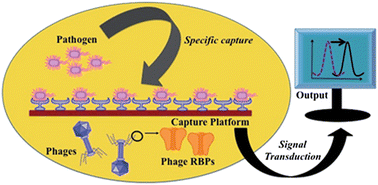Bacteriophage based probes for pathogen detection
Abstract
Rapid and specific detection of pathogenic bacteria is important for the proper treatment, containment and prevention of human, animal and plant diseases. Identifying unique biological probes to achieve a high degree of specificity and minimize false positives has therefore garnered much interest in recent years. Bacteriophages are obligate intracellular parasites that subvert bacterial cell resources for their own multiplication and production of disseminative new virions, which repeat the cycle by binding specifically to the host surface receptors and injecting genetic material into the bacterial cells. The precision of host recognition in phages is imparted by the receptor binding

- This article is part of the themed collection: 2012's Top 25 most read Analyst articles

 Please wait while we load your content...
Please wait while we load your content...